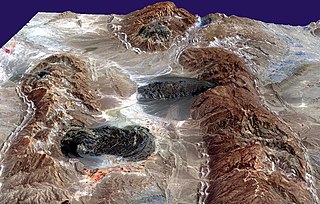Hormuz Formation

TheHormuz Formation,Hormuz Series,Hormuz EvaporitesorHormuz Groupis a sequence ofevaporitesthat were deposited during theEdiacaran(LateNeoproterozoic) toEarly Cambrian,a period previously referred to as the Infra-Cambrian. Most exposures of this sequence are in the form of emergentsalt diapirswithinanticlinesof theZagros fold and thrust belt.As a result of their involvement in post-depositionalsalt tectonics,the internal stratigraphy of the sequence is relatively poorly understood. They are the lateral equivalent of the evaporite-bearing Ara Group in theSouth Oman Basin.[1]
Distribution
[edit]The Hormuz Formation is known from a wide area of theZagros Mountainsand around and beneath thePersian Gulf.Two main depositional basins have been recognised, the North Gulf and South Gulf Basins, separated by the Qatar Arch. The basins were formed as a result ofextensional tectonicstowards the end of thePan-African Orogeny.The main structure formed during this period were NW-SE trending dextral (right lateral)strike-slip faultsand NE-SW trendingextensional faults.
Stratigraphy
[edit]Most occurrences of the Hormuz Formation are highly disturbed tectonically. However, a broad stratigraphy has been recognised.[2]
Effect on Zagros structure
[edit]Halite layers within the Hormuz sequence form the most importantdecollementlevel within the Zagros fold and thrust belt. The presence and thickness of the halites has had a major influence on the geometry of the thrust belt and such variations has been used to explain lateral changes in structural style along the belt.[3]
References
[edit]- ^Smith A.G. (2012). "A review of the Ediacaran to Early Cambrian ('Infra-Cambrian') evaporites and associated sediments of the Middle East". In Bhat G.M. (ed.).Geology and Hydrocarbon Potential of Neoproteozoic-Cambrian Basins in Asia.Special Publications. London:Geological Society.pp. 229–250.ISBN9781862393462.
- ^Talbot C.J.; Alvi M. (1996). "The past of a future syntaxis across the Zagros". In Alsop G.I.; Blundell D.J.; Davison I. (eds.).Salt Tectonics.Special Publications. Vol. 100.Geological Society.pp. 89–109.ISBN9781897799444.
- ^Bahroudi, A.; Koyi H.A. (2003)."Effect of spatial distribution of Hormuz salt on deformation style in the Zagros fold and thrust belt: an analogue modelling approach".Journal of the Geological Society.160(5). London: Geological Society: 719–733.doi:10.1144/0016-764902-135.S2CID131504678.
